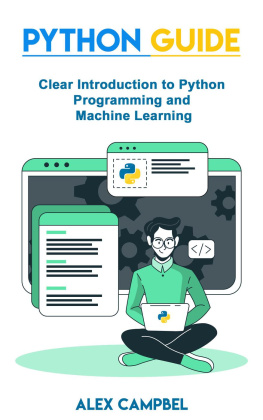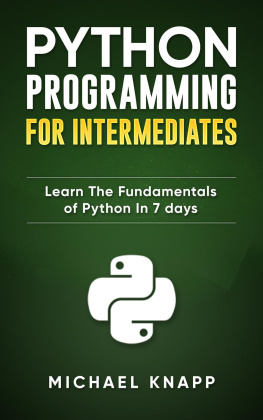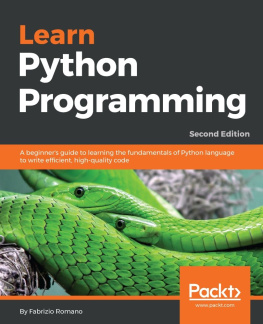ABSOLUTELY FREE! Simply click on the link above and enter your email address and Ill send you a FREE BOOK. Youll also get access to future promotions, free books and more!
From this free book you'll get tons of ideas for computer software, mobile/social networking apps, web site scripts and blog plug ins. You can use these ideas to create new ones to sell or to buy or use in your current business. These types of software can increase your profits, expand product line, increase your free time, lower your expenses, accelerate your traffic and lead to more business success.
Introduction
I want to thank you and congratulate you for downloading the book , Python Mastery: A code like a pro guide for python beginner s !
This book contains helpful steps and strategies on how to successfully use and manage this free programming language tool. This is made to be an interactive tutorial and guide in mind, so you can code on Python what you read here.
Programming is not a walk in the park. It requires a lot of patience, diligence, and understanding, with a bit of logical thinking from time to time. The high end programming for geniuses, but this ebook will help you get on the right track.
Thanks again for downloading this book, I hope you enjoy it!
Copyrigh t 2016 Jonathan Bates - All rights reserved.
This document is geared towards providing exact and reliable information in regards to the topic and issue covered. The publication is sold with the idea that the publisher is not required to render accounting, officially permitted, or otherwise, qualified services. If advice is necessary, legal or professional, a practiced individual in the profession should be ordered.
From a Declaration of Principles which was accepted and approved equally by a Committee of the American Bar Association and a Committee of Publishers and Associations.
In no way is it legal to reproduce, duplicate, or transmit any part of this document in either electronic means or in printed format. Recording of this publication is strictly prohibited and any storage of this document is not allowed unless with written permission from the publisher. All rights reserved.
The information provided herein is stated to be truthful and consistent, in that any liability, in terms of inattention or otherwise, by any usage or abuse of any policies, processes, or directions contained within is the solitary and utter responsibility of the recipient reader. Under no circumstances will any legal responsibility or blame be held against the publisher for any reparation, damages, or monetary loss due to the information herein, either directly or indirectly.
Respective authors own all copyrights not held by the publisher.
The information herein is offered for informational purposes solely, and is universal as so. The presentation of the information is without contract or any type of guarantee assurance.
The trademarks that are used are without any consent, and the publication of the trademark is without permission or backing by the trademark owner. All trademarks and brands within this book are for clarifying purposes only and are the owned by the owners themselves, not affiliated with this document.
Chapter 1: What is Python?

Python is a high-leveled, very useful and all-purposeprogramming language tool, named after a large, heavy-bodied, non-poisonous constrictor snake. Python has nothing to do with snakes or reptiles, unless you want to make a code about snakes, but tha t s getting ahead of ourselves.
Python is freely available and makes finding the solution to a computer problem just as simple as if you had written out your thoughts on how to find the solution. Python can be run on almost any computer without needing to change the program once the program is written.
Programming Languages
You have probably heard or seen programs like Java, JavaScript and C around, have you not? These are also programming languages. Programming languages are what allow programmers to develop software programs, scripts, and instructions for computers to follow.
There are a LOT more programming languages than those I have listed here, and some have very specific focus. Programming language can be used for different fields of programming, as listed down here:
- Application and Program Development: these involve programs you work with on daily. For example, an Internet browser program you use to view your favorite pages, or an app that allows you read ebooks such as this on your kindle, are examples of programs made this way.
- Artificial Intelligence Development: this is dedicated to making AIs, or cognitive systems, that can interact with human behavior and learn. Programs made here include character interactions on computer games, parts of programs that make decisions, and chatboxes that can reply back to the sender.
- Database Development: self-explanatory: you make and maintain mini-databases, which hold large quantities of digital information for people to look up and use. These are important for websites to have so they can compile information.
- Game Development: also self-explanatory: Computer games and other entertainment software can be written by language programs like Java (and flash games you can find online use that same script).
- Computer Drivers or other hardware interface development: programs made with this focus in mind support hardware functionality.
- Internet and Web Page Development: The lifeblood of the Internet. Without developers, there could be no web pages, and without web pages there was no Internet.
- Script Development: knowing how to make scripts can benefit any compan y s productivity.
Back to Python
Out of all the possible program developments, Python is a very dynamic programming language that is often used in script, while also capable of being compiled into executable programs (I.E. data files that are locked from normal reading because of their code is rewritten).
Named after the British Comedy Monty Pytho n s Flying Circus Guido von Rossum created it back in 1990. Now, Python is written and developed by a team of volunteers and is easily accesable through the Python Software Foundation. In September of 2006, Python released its most updated version, Python 2.5.
There are other versions of Python such as the Java based version Jython which is used to work with a Java coded program..Netand Mono platforms work with the Iron Python which is a C# version of Python. With the C# version, programmers are given access to all of Pytho n s power and flexibility.
Using both Python and Java work with a substantial library of pre0written code as well as object-oriented that allows it to run on almost any operating system. Python programs are usually complied at the time that the program is running, so that the interpreter reads the program. There is however a way for the program to be compiled into a readable machine code. Additionally, Python does not need an intermediary step in order to perform independently. The platform independence is in the implementation of the interpreter.
Chapter 2: Why Learn Python
Python is an interactive, interpreted program language (interpreted means it does not need to be compiled before executed, but requires an interpreter to modify the script). Python is also object-oriented (in which it is possible to interact and/or execute multiple programs at once).







